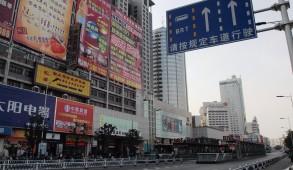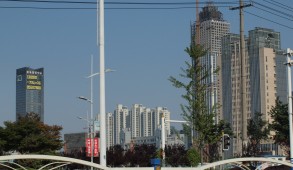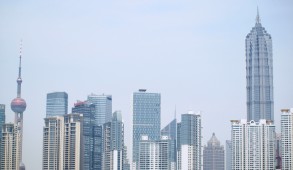
We select seven of the sixteen municipalities of the Yangzi delta regionto highlight the different geographical and ecological conditions. These municipalities are all sizeable economic centers in the region and broadly represent the diversity of development approaches of the regional economy.
The seven cities reflect different historical legacies and varying political and economic starting conditions at the outset of reforms.
Wenzhou is a port city located eighteen miles from the coast of the East China Sea on the river Ou, which gives access to the mountainous interior of southern Zhejiang Province. With a land area of 4,550 square miles, its administrative area includes more than 10 percent of Zhejiang Province. Ninety-six percent of this area is classified as rural, with more than 60 percent of the residents living in villages and townships. Commercial culture in Wenzhou dates back to the Song Dynasty (960–1279), when market production specialized in various crops and handicrafts and merchants were highly skilled in long-distance trading.

Ningbo, a city of more than 5.5 million residents, is located in the Ningshao alluvial plain along the coast of Zhejiang Province, south of the mouth of the Yangzi River. Thanks to its privileged geographic location, the city has a long history of sea trade dating back to the Qin Dynasty (221–207 B.C.). In the Mao era, Ningbo lost its role as a trading port. Like Wenzhou to the south, its manufacturing economy remained largely dormant because the state bypassed the city as a site for investment in industrial development. Ningbo’s inclusion as one of the coastal cities opened in 1984, however, quickly revitalized the city’s commercial and trade tradition. By 2009, Ningbo was home to the second-largest container port in China and the fourth-largest container port in the world, also handling a large portion of Shanghai’s foreign trade. By 2005, 20 of China’s 190 most important export brands were located in this municipality.

Hangzhou, a city of 6.6 million residents, is located about 110 miles west of Shanghai, surrounded by lush hills and situated on the West Lake and the southern end of China’s Grand Canal connecting the city with Beijing in the north. It is one of China’s oldest settlements, with a history dating back almost 5,000 years, while the city proper was founded about 2,200 years ago in the Qin Dynasty. The population size at the end of the thirteenth century may have been above 1 million, making Hangzhou the largest city in the world at that time. During the Mao era, Hangzhou, as the provincial capital of Zhejiang, received relatively strong central support. This has led to the buildup of a strong state and collective sector in Hangzhou’s economy. After the opening of reforms, the municipal government initially sought to maintain and expand the existing public industrial sector. At the end of the 1990s, the city faced strong competition from municipalities in the Yangzi delta region that were more supportive of private enterprise, and it fell behind in economic development. This loss in regional competitiveness eventually forced the local leadership to adopt a more private-business-friendly policy. Supported by a strong educational base, with thirty-five universities and colleges located in Hangzhou, the new strategy was quickly successful. Already in 2004, the Forbes list of the best business environments ranked Hangzhou number one in China, a ranking that was repeated in five consecutive years.

Changzhou is a prefecture-level city of 3.5 million residents in southern Jiangsu Province bordering Nanjing to the east. The city’s economic history dates back to ad 609, when the town developed as a transshipment point and commercial center for agricultural trading on the Grand Canal. Main products were rice, fish, tea, and silk. A cotton industry grew in the 1920s, and subsequently the city emerged as a center of textile production. Under Maoist rule, engineering and mechanical industries were added. Through heavy reliance on the creation of collective township village enterprises in the 1980s and early 1990s, Changzhou was initially extremely successful in limiting rural poverty. Large-scale collective firms run by local government provided the initial growth impetus of the post-reform period. The focus on collective firms left little room for private firm development. Only when marketization expanded in the 1990s, and collective firms began to gradually lose their relative advantage as organizational hybrids, did market entry of private firms accelerate.

Nanjing is today home to 7.5 million residents. Located on the Yangzi River and surrounded by the Ningzheng Ridge, the city is approximately 180 miles west of Shanghai. Nanjing is one of the great historical sites of China. It was the capital of six dynasties and of the Republic of China. Economically, the city is privileged in its rich natural resource endowments. Among the more than forty different minerals found in or near Nanjing, iron and sulfur have the greatest reserves. During the Ming Dynasty (1368–1644), Nanjing reached an early peak in its economic and political development, becoming a commercial center in East Asia, especially for textiles, printing, and shipbuilding. Around 1400, Nanjing was even among the most prosperous cities in China and globally. After the establishment of the People’s Republic of China, Nanjing was chosen as the capital of Jiangsu Province. In the following years, massive investments built up a heavy industry base. The emphasis was on electrical, mechanical, chemical, and steel production, which turned Nanjing into a national center of heavy industry. Today, large-scale state-owned firms such as Panda Electronics, Jincheng Motors, and Nanjing Steel still shape the city’s industrial landscape.

Nantong is a prefecture-level coastal city of more than 7.5 million residents in Jiangsu Province, located on the northern bank of the Yangzi River. Historically (with records dating back to ad 958) the city has played only a minor role in the economic development of the Yangzi delta. Commerce concentrated on salt production on the seacoast, and also rice and cotton. By the early twentieth century, the textile industry was also of some significance. Nantong was one of the fourteen coastal cities designated by the central government to be opened for international trade and investment in 1984, and thus foreign direct investment played a crucial role throughout the economic reforms. Nantong’s proximity to Shanghai and its geographic location on the banks of the Yangzi River with its own seaport contributed to its development into a major industrial hub. Today, Nantong is one of the fastest-growing coastal cities, with large areas of the municipality’s 3,000 square miles dominated by new industry construction. Between 2003 and 2006, contracted foreign direct investments tripled, reaching $6.9 billion. In parallel, total industrial investment in fi xed assets increased by more than 230 percent. The textile industry’s historical strength was maintained, but complemented by factories producing machinery, electronics, and chemicals.

The administrative region of Shanghai covers more than 2,430 square miles in the Yangzi delta. Located on the mouth of the Huangpu River, it extends seventy miles from north to south and sixty miles from east to west. The city proper covers only about 12 percent of this; the remainder of the municipality includes periurban townships and vast rural areas in the alluvial plain of the Yangzi River. Today, Shanghai has more than 18.6 million residents, 4.7 million of whom are temporary migrants. Shanghai’s historical records date back to ad 960. During the Ming (1368–1644) and Qing (1644–1912) dynasties, the city developed into a trading port, with transport routes for cotton connecting the Yangzi delta with Beijing and Japan. Shanghai emerged as the region’s commercial center when it was opened after the opium wars in 1842 for trade with the European powers.

